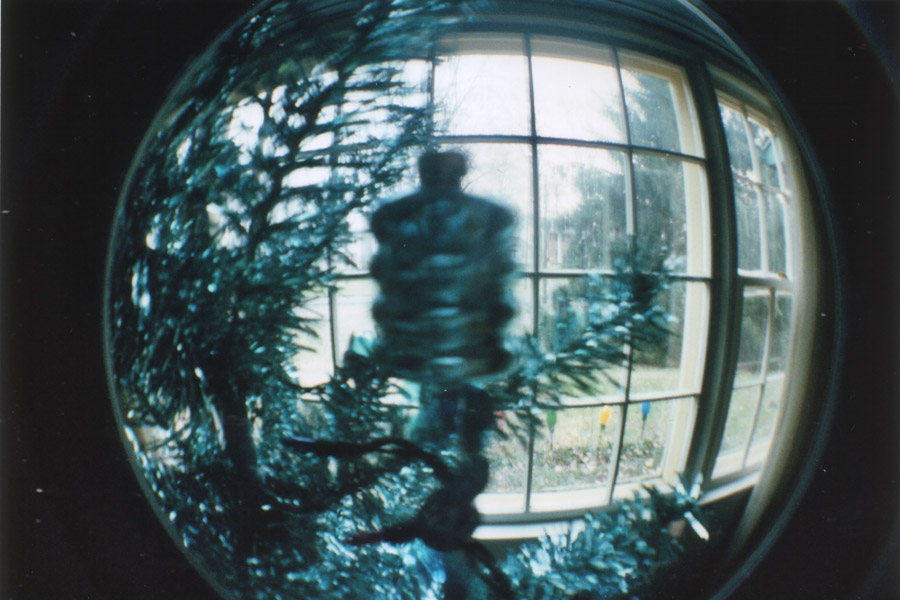Christmas is over, but I didn’t have the camera that took these pictures before Christmas, and it takes time to get film developed, so here are a couple of festive holiday shots taken with one of my Christmas gifts, a Lomography Society Fisheye 2 camera.


Posted at 1:46 AM
Link to this entry
Kimberly Blessing answers a post by Ian Lloyd on Accessify asking how people got interested in web accessibility. I’ve been interested in and aware of it as long as I’ve been making web sites.
In 1993, I was working for AT&T, and the head of my department at the time was a man who happened to be blind. He was a really nice guy, one of the best bosses I’ve ever had, smart as a whip. He was a ham radio operator, among other things, so we shared an interest in radio. (I still remember laughing when he told me that he had started doing maintenance work on his antenna tower at night because it made the neighbors nervous to see him climbing the tower during daylight.) He had a PhD in Computer Science from the University of Illinois (class of 1976), and his thesis was in text-to-speech synthesis. As part of his work in school, he had adapted a VT-100 terminal to speak what was on his screen, and he was still using that piece of hardware when I worked for him 17 years later. It was kind of an organizational accident that I worked for him; I wouldn’t normally think of putting a technical writing organization (where I worked) under an IT infrastructure support group. Someone else eventually figured that out as well, because they moved us elsewhere in the organization after about a year. But working in that group at that time was critical to my getting into the web. I discovered the web in April, 1993, when the U of I released Mosaic 0.4 for X Windows-based computers (support for PCs and Macs wouldn’t happen until October of that year). Because we worked so closely with the people who administered the UNIX machines we worked on, I was able to show a couple of my colleagues on the IT side this neat program and get them interested enough that they were happy to download the CERN server software and set up a sandbox for me to play in. This was at a time when there were about 100 web servers in the world. At the time, there weren’t too many browsers available; Mosaic, Cello, and a line-mode browser that CERN created for people who were on telnet connections come to mind. I seem to recall that my friends in the IT group also downloaded the CERN line-mode browser, and that my boss was able to use it to browse the sites we created. So it was basically imprinted on me right for the very beginning of my time on the web that accessibility was A Good Thing and the right way to create web sites. I can’t say that it was all that much of a concern at the time, though; you couldn’t use tables for layout, for example, because Mosaic didn’t support tables until version 2.0. The web was pretty much inherently accessible at the time (I suppose skipping the ALT attribute on images was the main accessibility problem at the time).
So anyway, it was something I was aware of as being important from the very start. When David Siegel ruined the web, it became more of an issue, and one that I had to fight hard to uphold. I didn’t always win at work.
But on the sites I developed on my own outside work, I still did my level best to ensure that they were accessible. I had one other incentive on that count: my interest in shortwave radio. Shortwave radio is a fairly obscure hobby, but I was aware of a number of blind people who were very interested in it. And it makes sense that they would make heavy use of radio. Assuming the hardware was accessible, radio presents no obstacles to the blind; we’re all blind when we listen to the radio. Reviews of various shortwave receivers on the market always made a point to discuss their accessibility; this receiver had a small bump on the "5" key so users would have a way of telling where they were on the keypad, that receiver had a speech synthesizer option to read out the tuned frequency, that sort of thing. So when I developed a site for the radio club I volunteer for, I was very aware that shortwave radio has a small but significant blind audience. When I first created a site for the club in 1995, I made little use of tables, no use of Javascript, basically just a state-of-the-art design (for the time) that (mostly) didn’t get in the way of users with screen readers. Feedback from blind users over the years noted that the site was almost entirely accessible to them, even to users of Lynx. (There was an issue with one popup menu on one important page that was too long for some screen reader users; my programming chops weren’t up to fixing that at the time, but I remembered that when I redesigned the site in 2005.) Accessibility had other benefits as well; the site was number 1 in the search results on Google for the terms "shortwave" and "shortwave radio" for many years at its original URL.
Over the years I’ve always tried to keep my accessibility chops up-to-date. There wasn’t a whole lot of material available on the subject in the early days. There was a book published in 1997 by the unfortunately-named Crystal Waters, Universal Web Design, that must have sold about five copies in the face of a market that wanted to create killer web sites. After that, there was very little in print until Joe Clark’s book in 2002. As the years have passed, I’ve become aware of more aspects of accessibility (deafness, dyslexia, etc.) and have incorporated that awareness into my site creation activities as best I can. The redesign of the shortwave club web site in 2005 was my best opportunity to date to exercise my knowledge in the field. I even did my best to make a couple of features on the site that were AJAX-based accessible (mainly by using progressive enhancement to a non-Javascript-based version of those features and then allowing people to turn off the AJAX-based functionality and revert to the non-Javascript-based version if need be; at the time nobody was sure what parts of AJAX were accessible and what parts weren’t, so that seemed to be the best course). Honestly, I’m not 100% positive that those features of the site are fully accessible. I haven’t had access to testers since the redesign. But I’m committed to updating the site to keep it as state-of-the-art accessible as possible.
I haven’t had much luck in convincing employers to take advantage of my passion for accessibility in recent years. I’ve tried to sell it as search engine optimization, and have had some success in that way, but it’s still pretty frustrating being, as Ian put it, "the guy at the bottom of a pit ranting about accessibility and trying to be heard". Wish I had a solution to that one. Right now I think my solution is to look for another employer....
Posted at 2:23 PM
Link to this entry || 1 comment

